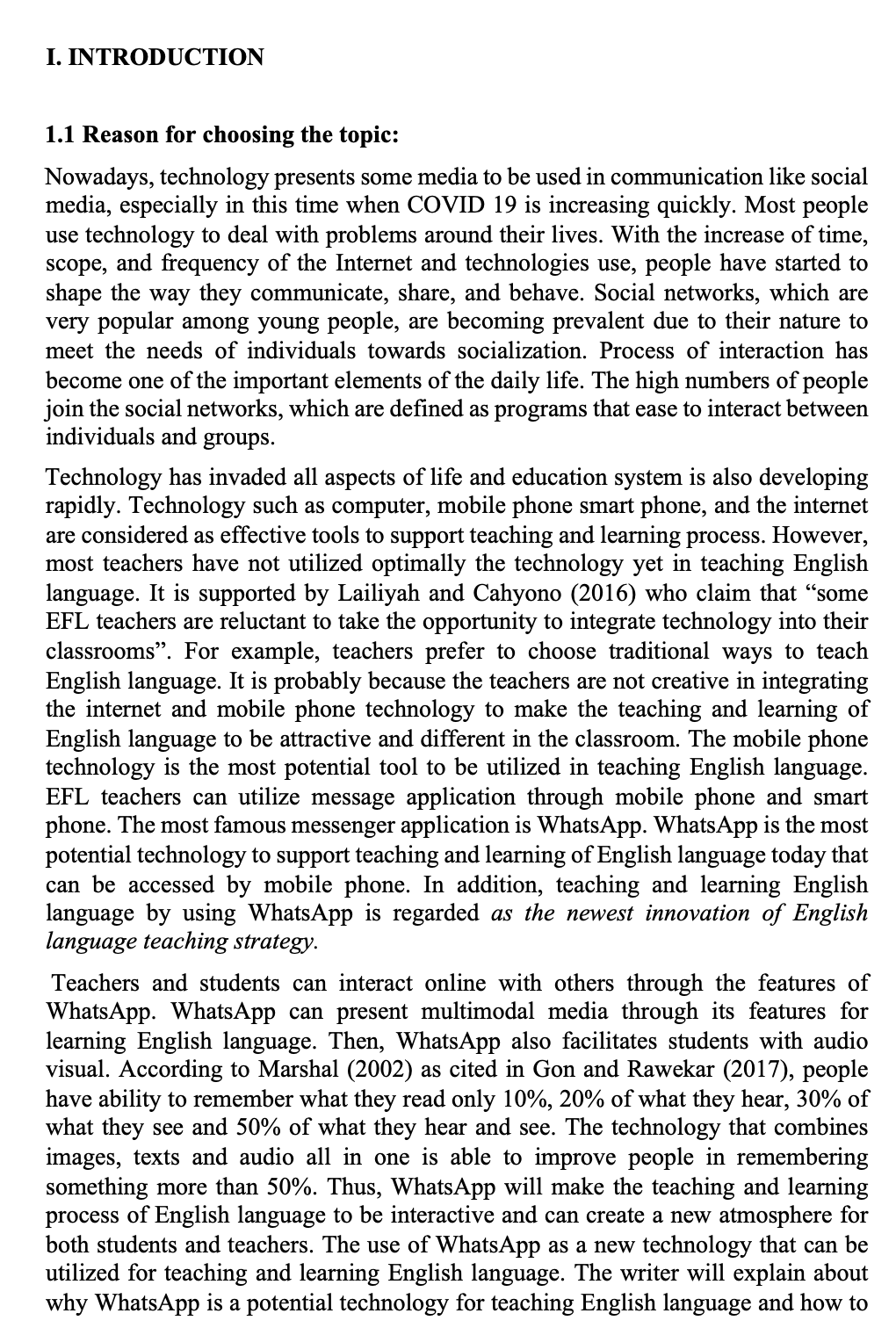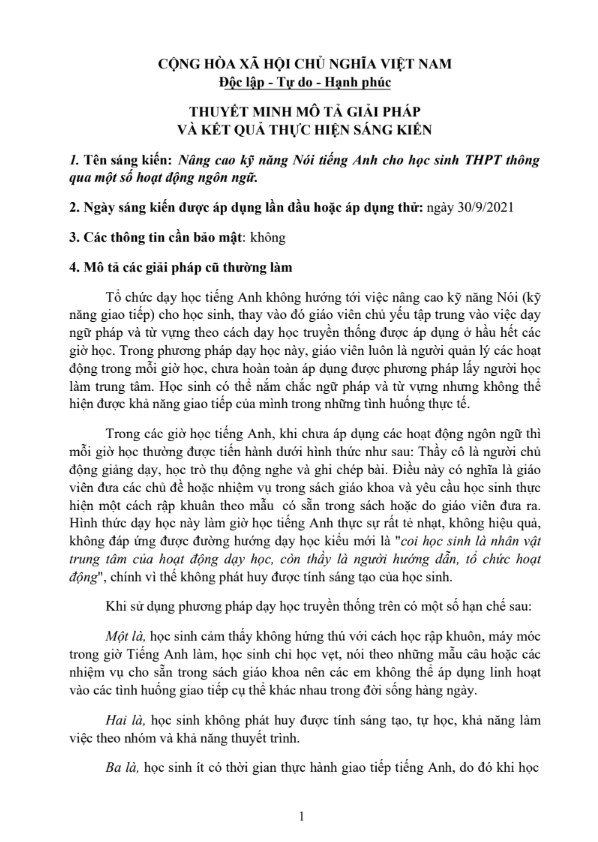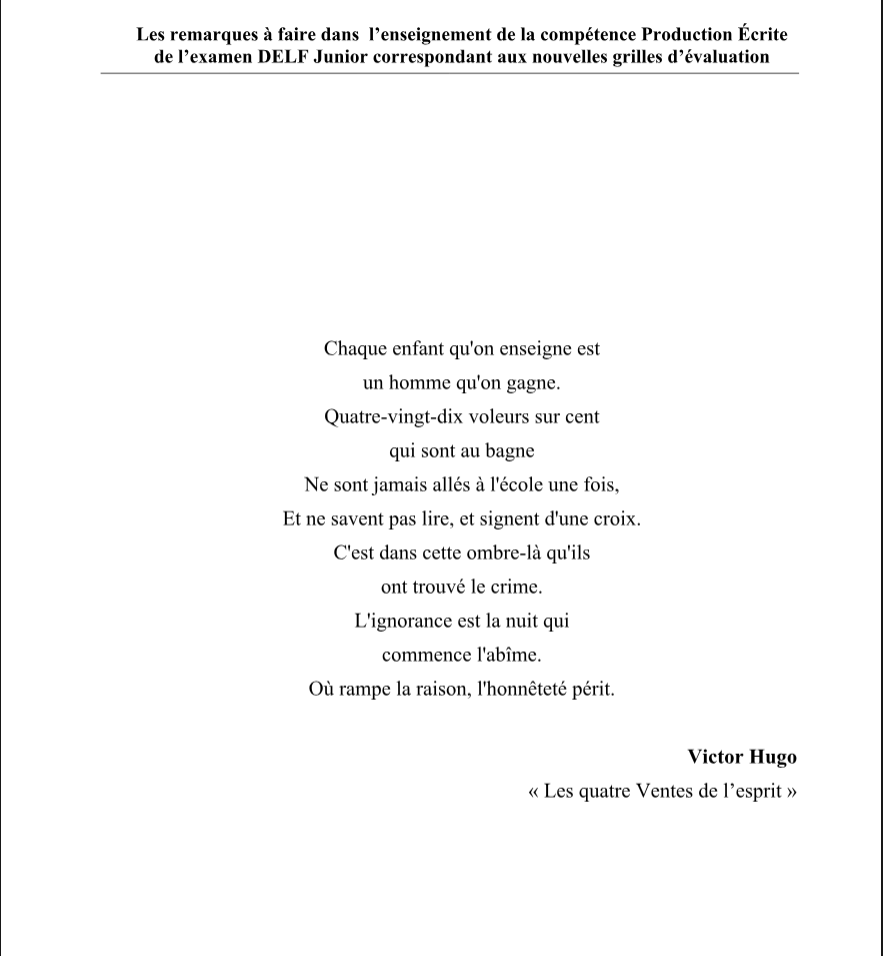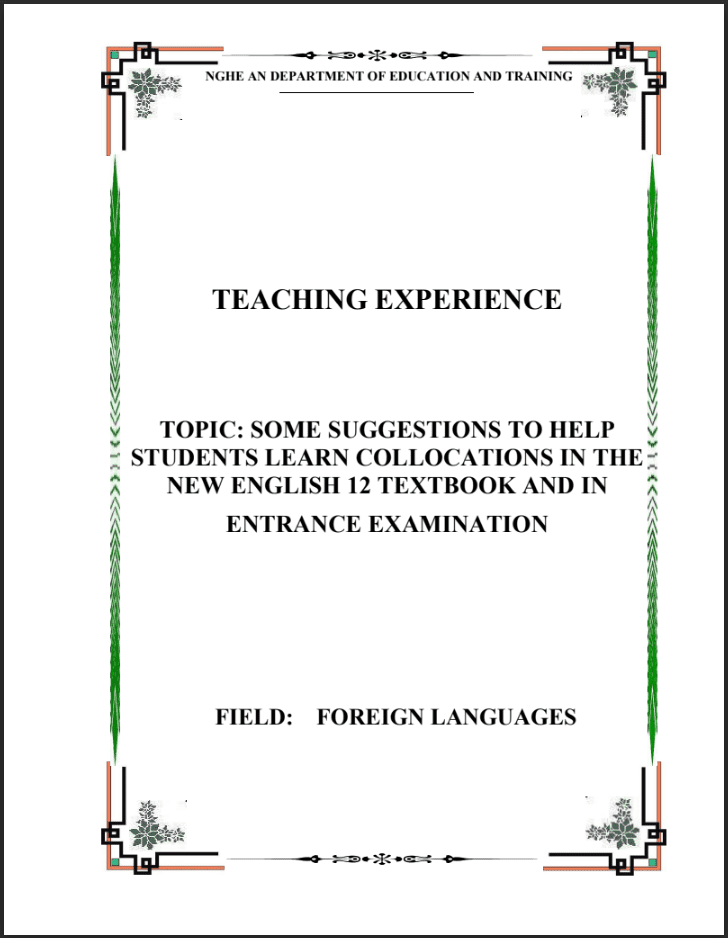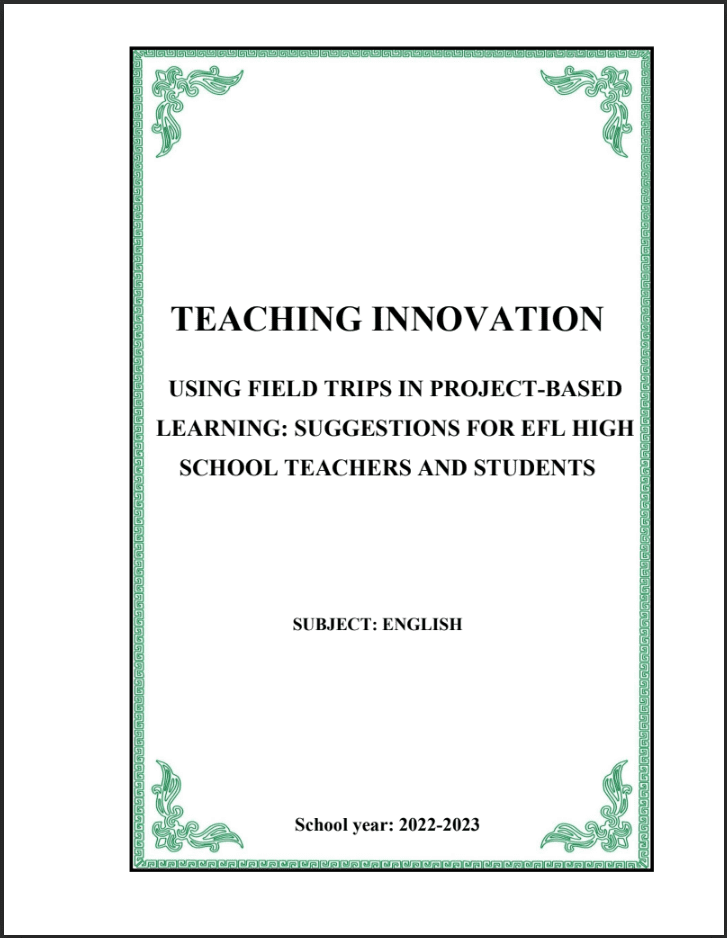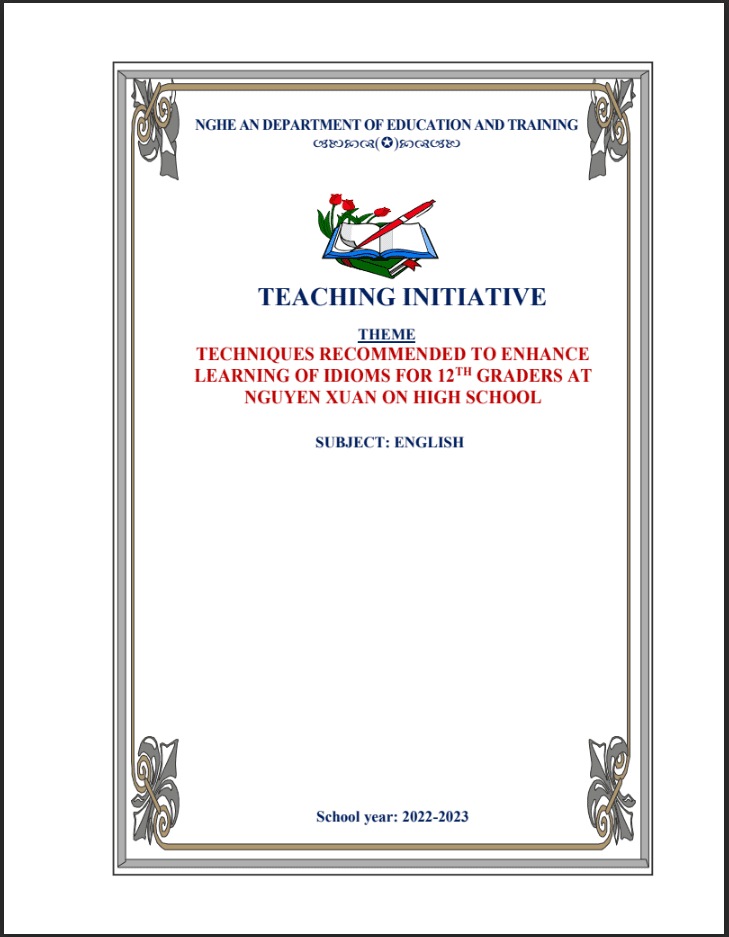SKKN Applying WhatsApp group discussion to improve 10th students’ ability in writing skill at Dien Chau 2 high school, ESPECIALLY FOR offline learning
- Mã tài liệu: MP0043 Copy
| Môn: | Tiếng anh |
| Lớp: | 11 |
| Bộ sách: | |
| Lượt xem: | 812 |
| Lượt tải: | 6 |
| Số trang: | 37 |
| Tác giả: | Trần Thị Lan Anh |
| Trình độ chuyên môn: | Thạc sĩ giáo dục |
| Đơn vị công tác: | THPT Diễn Châu 2 |
| Năm viết: | 2021-2022 |
| Số trang: | 37 |
| Tác giả: | Trần Thị Lan Anh |
| Trình độ chuyên môn: | Thạc sĩ giáo dục |
| Đơn vị công tác: | THPT Diễn Châu 2 |
| Năm viết: | 2021-2022 |
Sáng kiến kinh nghiệm “SKKN Applying WhatsApp group discussion to improve 10th students’ ability in writing skill at Dien Chau 2 high school, ESPECIALLY FOR offline learning” triển khai gồm các biện pháp nổi bật sau:
Step 1. Create a WhatsApp group:
Step 2. Set the rules:
Step 3. Set up for class use:
Step 4. Assign the tasks:
Mô tả sản phẩm
- INTRODUCTION
1.1 Reason for choosing the topic:
Nowadays, technology presents some media to be used in communication like social media, especially in this time when COVID 19 is increasing quickly. Most people use technology to deal with problems around their lives. With the increase of time, scope, and frequency of the Internet and technologies use, people have started to shape the way they communicate, share, and behave. Social networks, which are very popular among young people, are becoming prevalent due to their nature to meet the needs of individuals towards socialization. Process of interaction has become one of the important elements of the daily life. The high numbers of people join the social networks, which are defined as programs that ease to interact between individuals and groups.
Technology has invaded all aspects of life and education system is also developing rapidly. Technology such as computer, mobile phone smart phone, and the internet are considered as effective tools to support teaching and learning process. However, most teachers have not utilized optimally the technology yet in teaching English language. It is supported by Lailiyah and Cahyono (2016) who claim that “some EFL teachers are reluctant to take the opportunity to integrate technology into their classrooms”. For example, teachers prefer to choose traditional ways to teach English language. It is probably because the teachers are not creative in integrating the internet and mobile phone technology to make the teaching and learning of English language to be attractive and different in the classroom. The mobile phone technology is the most potential tool to be utilized in teaching English language. EFL teachers can utilize message application through mobile phone and smart phone. The most famous messenger application is WhatsApp. WhatsApp is the most potential technology to support teaching and learning of English language today that can be accessed by mobile phone. In addition, teaching and learning English language by using WhatsApp is regarded as the newest innovation of English language teaching strategy.
Teachers and students can interact online with others through the features of WhatsApp. WhatsApp can present multimodal media through its features for learning English language. Then, WhatsApp also facilitates students with audio visual. According to Marshal (2002) as cited in Gon and Rawekar (2017), people have ability to remember what they read only 10%, 20% of what they hear, 30% of what they see and 50% of what they hear and see. The technology that combines images, texts and audio all in one is able to improve people in remembering something more than 50%. Thus, WhatsApp will make the teaching and learning process of English language to be interactive and can create a new atmosphere for both students and teachers. The use of WhatsApp as a new technology that can be utilized for teaching and learning English language. The writer will explain about why WhatsApp is a potential technology for teaching English language and how to use WhatsApp in teaching English language, especially for online learning in Viet Nam where is influenced seriously by COVID 19.
I would like to share my teaching experience “Applying WhatsApp group discussion to improve 10th students’ ability in writing skill at Dien Chau 2 high school, especially for offline learning” in the hope that my colleagues can apply in teaching and we can discuss more to get the best result in teaching students how to write effectively.
1.2. Objectives of the study:
This study aims at examining the effectiveness of WhatsApp on developing EFL Students’ writing skills.
1.3. Hypothesis of the study
This study has hypothesized that using WhatsApp English medium groups for chatting and sharing news articles or topic with requesting students to read and comment on are effective in developing students ‘writing skills.
1.4. Research Methodology
This study presents a practical work that examined the effectiveness of WhatsApp on developing students ‘writing skills in English as a foreign language. a. Participants
The participants of this study are students from grade 10A and 10D at Dien Chau 2 high school. They were requested to join a WhatsApp group for developing their English, especially in writing skills for online or offline learning. All the participants are all students feel comfortable to participate in WhatsApp group and share the mobile numbers with their male classmates for social considerations. b. Data collection instruments:
The data were collected through their writing ‘performance before and after applying the research and researcher’ daily observations of students’ progress and a questionnaire given to the participants at the end of the study. The pre-test and post-test based on writing tasks given to students when they joined the group and later on at the end of the study period in addition to assessing their chats in the group in the first week. Researcher’s daily observations aimed at noticing students’ progress in writing. A questionnaire prepared by the researcher was also given to their opinions regarding the effectiveness of the WhatsApp in developing their writing skills based on the experience they had during the study
II. THE CONTENT
- THEORICAL AND PRACTICAL BACKGROUND
- Theorical background
1.1.1. Definition of teaching writing skill:
Writing is a skill that is highly required nowadays. Written communication, for example, is the most common form of business communication. Emails and formal letters fulfill conversational-like purposes that the students have to master if they were to integrate today’s job market. Writing serves not only communicative purposes in professional activities but also in social ones. In our everyday lives, we write or reply to invitation letters, thank-you letters, text messages, etc. Even journals carry a social-communicative load. Journal writers try to communicate their thoughts and feelings to themselves.
How to teach writing presupposes some prerequisites. Teachers should be aware of not only the theoretical underpinnings of the writing tasks but also the practical procedures that contribute to the success of the writing lesson. In the following section, we will have a look at:
- The basic knowledge that learners should develop in the writing lesson. o The different types of writing activities.
- Writing as a tool for learning. o Writing as a major syllabus component.
- Teaching writing as a product, as a process, and as a genre.
To make the writing to be qualified, students need to read a lot to enrich the information and idea related to the topic of the writing. It is because writing and reading activities go together in such a way that completes each other. So, teachers can do vary activity in teaching writing in the school by using WhatsApp.
1.1.2. Technologies in language learning:
Technology has a positive effect on both teacher and the learner. Lam and Lawrence (2002) claim that technology provides learners with regulation of their own learning process and easy access to information the teacher may not be able to provide. The wireless portable devices such as IPods, MP3 players, smart phones (like Blackberry, iPhone), and Personal Digital Assistants (PDAs) could provide opportunities to respond to the need of this generation. Evans (2008) believes that a distinguishable feature of mobile learning or M-learning is the potential to study when travelling on transport.
English language Teaching History Language teaching has witnessed four main stages. They are the following:
- Face to face instruction. This is the beginning of teaching that continued till now. It depends on the existence of the producer (tutor or instructor), the receiver (the learner) in one place.
- Distance learning: Historically, distance education has not been isolated from the use of technology to support learners and learning. Nipper (1989) classified three different generations of technology use over distance education in the twentieth century. According to him, the initial emphasis was solely on the printbased model of teaching. Nowadays, distance education offers a variety of digital technologies, including websites and digital libraries as well as communication tools such as email, virtual learning environments (VLEs) and the recent application of social networking and blogging. This is referred as ‘social media’ and it relies on free shared digital content that is authored, critiqued, and reconfigured by the community of users rather than individuals (Lee, 2009).
- Blended learning It represented the middle stage between this technique of teaching tries to make benefit of both previous ones. Through this stage, researchers make the best use if face to face environment and distance learning environment (Abdul Fattah, 2012)
- Mobile learning: There is an increased use of wireless technologies in education all over the world. In fact, wireless technologies such as laptop computers, and mobile phones are revolutionizing education and transforming the traditional classroom-based learning and teaching into anytime and anywhere education. The term “mobile learning” or “m-learning”, is not a new one. It describes learning of the learners’ not defined location or when he or she uses the benefits of mobile technology when learning. The strengths of mobile learning lie primarily in the use of learning programs not dependent on time or place, that are in the extremely efficient use of the available time. Therefore, the vision behind this is the learning is to get what you want, where you want and when you want. Mobile learning importance has increased since the beginning of the twenty first century. The following figure shows to what extent is mobile learning is important for youth. They can be as follows:
- For kids, mobile is not important for them.
- 75% of 12–14-year-old uses a mobile phone.
- 90% of 15- 17-year-old use a mobile phone.
1.1.3. Importance of Mobile Learning in Education:
Berger, (2001) lists the implications that mobile technology can bring to teaching and learning:
- Better realization of “anywhere, anytime”
- Freedom of organization in and out of the classroom,
- Collaboration among students separated geographically,
TÀI LIỆU LIÊN QUAN
- 7
- 105
- 1
- [product_views]
- 5
- 173
- 2
- [product_views]
- 4
- 165
- 3
- [product_views]
- 4
- 129
- 4
- [product_views]
100.000 ₫
- 6
- 434
- 5
- [product_views]
100.000 ₫
- 2
- 507
- 6
- [product_views]
100.000 ₫
- 9
- 546
- 7
- [product_views]
100.000 ₫
- 4
- 409
- 8
- [product_views]
100.000 ₫
- 2
- 595
- 9
- [product_views]
100.000 ₫
- 0
- 538
- 10
- [product_views]

